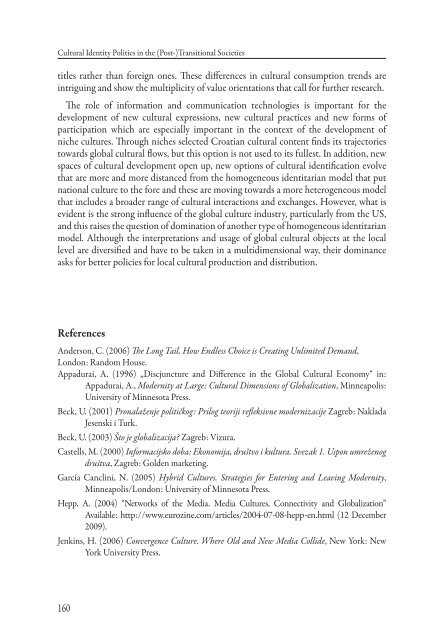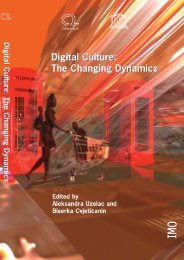free download in pdf format - Culturelink Network
free download in pdf format - Culturelink Network
free download in pdf format - Culturelink Network
Create successful ePaper yourself
Turn your PDF publications into a flip-book with our unique Google optimized e-Paper software.
Cultural Identity Politics <strong>in</strong> the (Post-)Transitional Societies<br />
titles rather than foreign ones. Th ese diff erences <strong>in</strong> cultural consumption trends are<br />
<strong>in</strong>trigu<strong>in</strong>g and show the multiplicity of value orientations that call for further research.<br />
Th e role of <strong>in</strong><strong>format</strong>ion and communication technologies is important for the<br />
development of new cultural expressions, new cultural practices and new forms of<br />
participation which are especially important <strong>in</strong> the context of the development of<br />
niche cultures. Th rough niches selected Croatian cultural content fi nds its trajectories<br />
towards global cultural fl ows, but this option is not used to its fullest. In addition, new<br />
spaces of cultural development open up, new options of cultural identifi cation evolve<br />
that are more and more distanced from the homogeneous identitarian model that put<br />
national culture to the fore and these are mov<strong>in</strong>g towards a more heterogeneous model<br />
that <strong>in</strong>cludes a broader range of cultural <strong>in</strong>teractions and exchanges. However, what is<br />
evident is the strong <strong>in</strong>fl uence of the global culture <strong>in</strong>dustry, particularly from the US,<br />
and this raises the question of dom<strong>in</strong>ation of another type of homogeneous identitarian<br />
model. Although the <strong>in</strong>terpretations and usage of global cultural objects at the local<br />
level are diversifi ed and have to be taken <strong>in</strong> a multidimensional way, their dom<strong>in</strong>ance<br />
asks for better policies for local cultural production and distribution.<br />
References<br />
Anderson, C. (2006) Th e Long Tail. How Endless Choice is Creat<strong>in</strong>g Unlimited Demand,<br />
London: Random House.<br />
Appadurai, A. (1996) „Discjuncture and Diff erence <strong>in</strong> the Global Cultural Economy“ <strong>in</strong>:<br />
Appadurai, A., Modernity at Large: Cultural Dimensions of Globalization, M<strong>in</strong>neapolis:<br />
University of M<strong>in</strong>nesota Press.<br />
Beck, U. (2001) Pronalaženje političkog: Prilog teoriji refl eksivne modernizacije Zagreb: Naklada<br />
Jesenski i Turk.<br />
Beck, U. (2003) Što je globalizacija? Zagreb: Vizura.<br />
Castells, M. (2000) Informacijsko doba: Ekonomija, društvo i kultura. Svezak 1. Uspon umreženog<br />
društva, Zagreb: Golden market<strong>in</strong>g.<br />
García Cancl<strong>in</strong>i, N. (2005) Hybrid Cultures. Strategies for Enter<strong>in</strong>g and Leav<strong>in</strong>g Modernity,<br />
M<strong>in</strong>neapolis/London: University of M<strong>in</strong>nesota Press.<br />
Hepp, A. (2004) “<strong>Network</strong>s of the Media. Media Cultures, Connectivity and Globalization”<br />
Available: http://www.euroz<strong>in</strong>e.com/articles/2004-07-08-hepp-en.html (12 December<br />
2009).<br />
Jenk<strong>in</strong>s, H. (2006) Convergence Culture. Where Old and New Media Collide, New York: New<br />
York University Press.<br />
160



